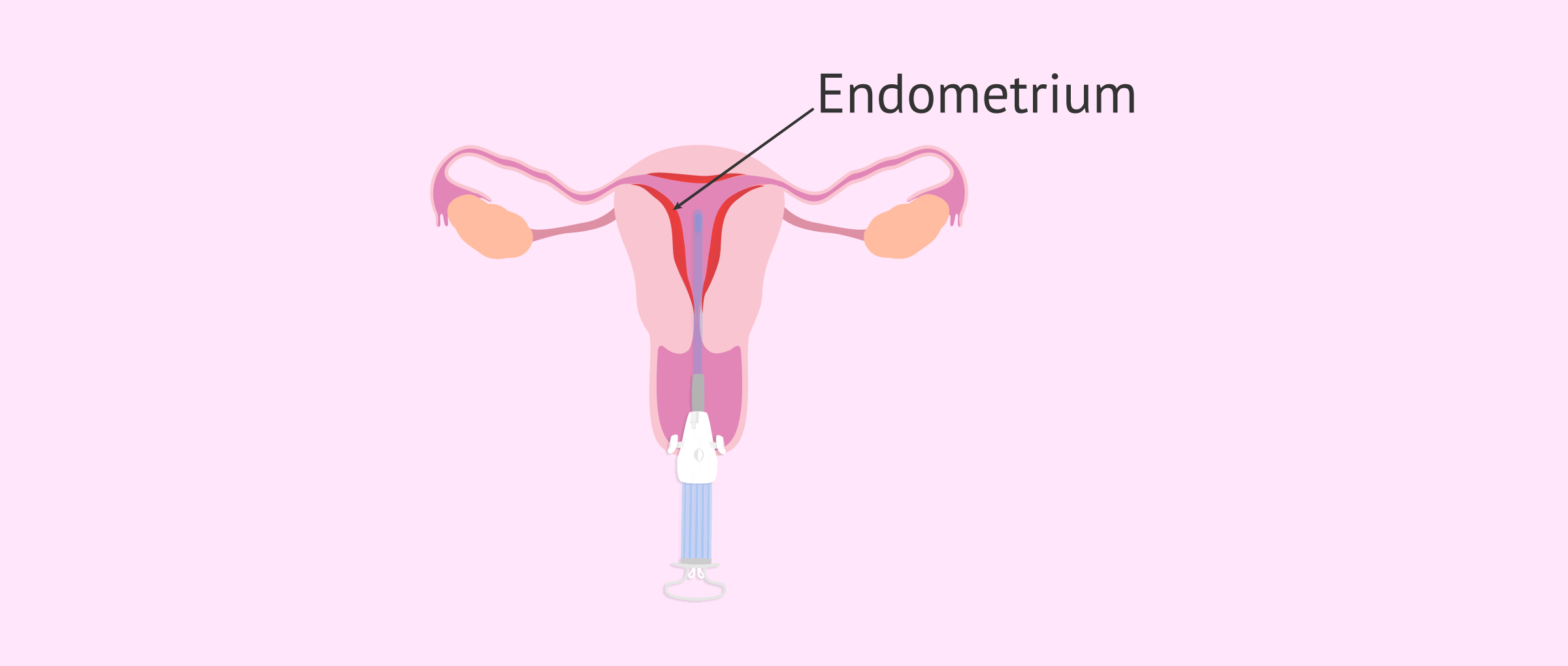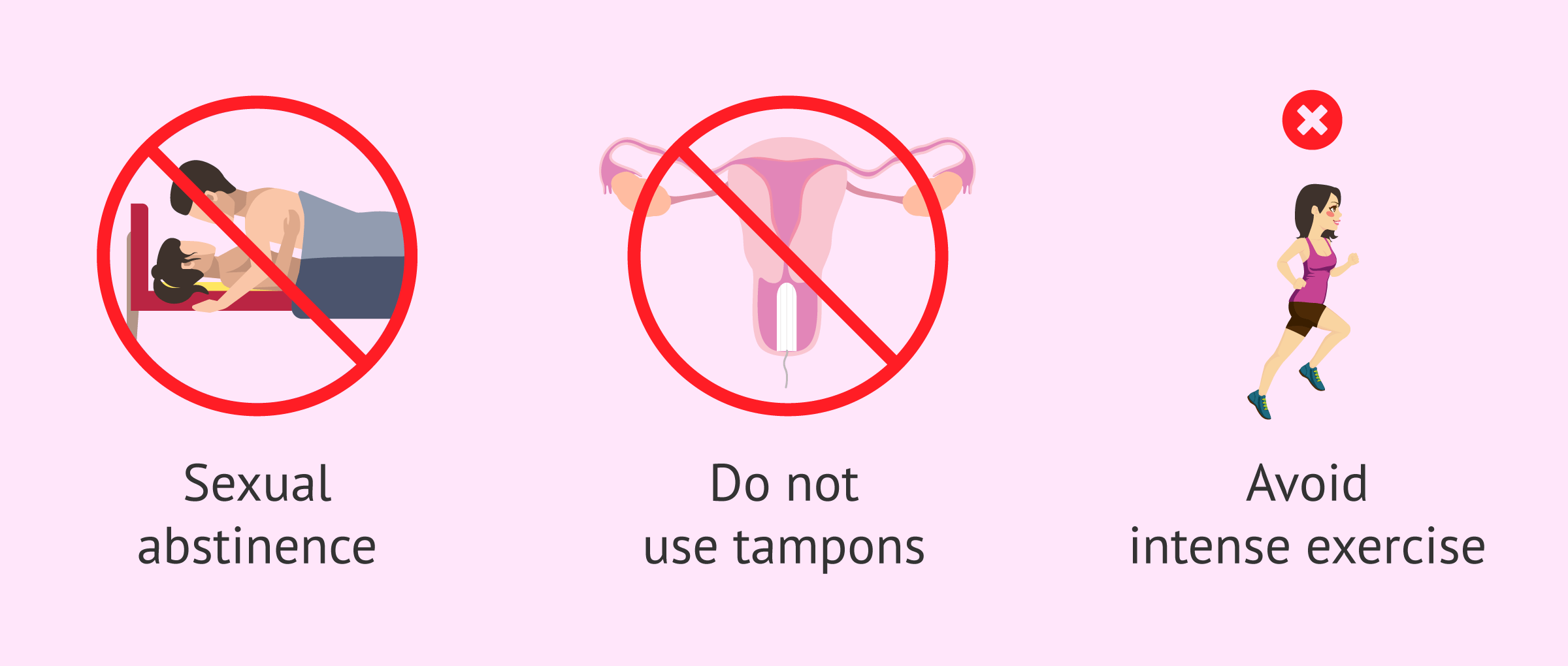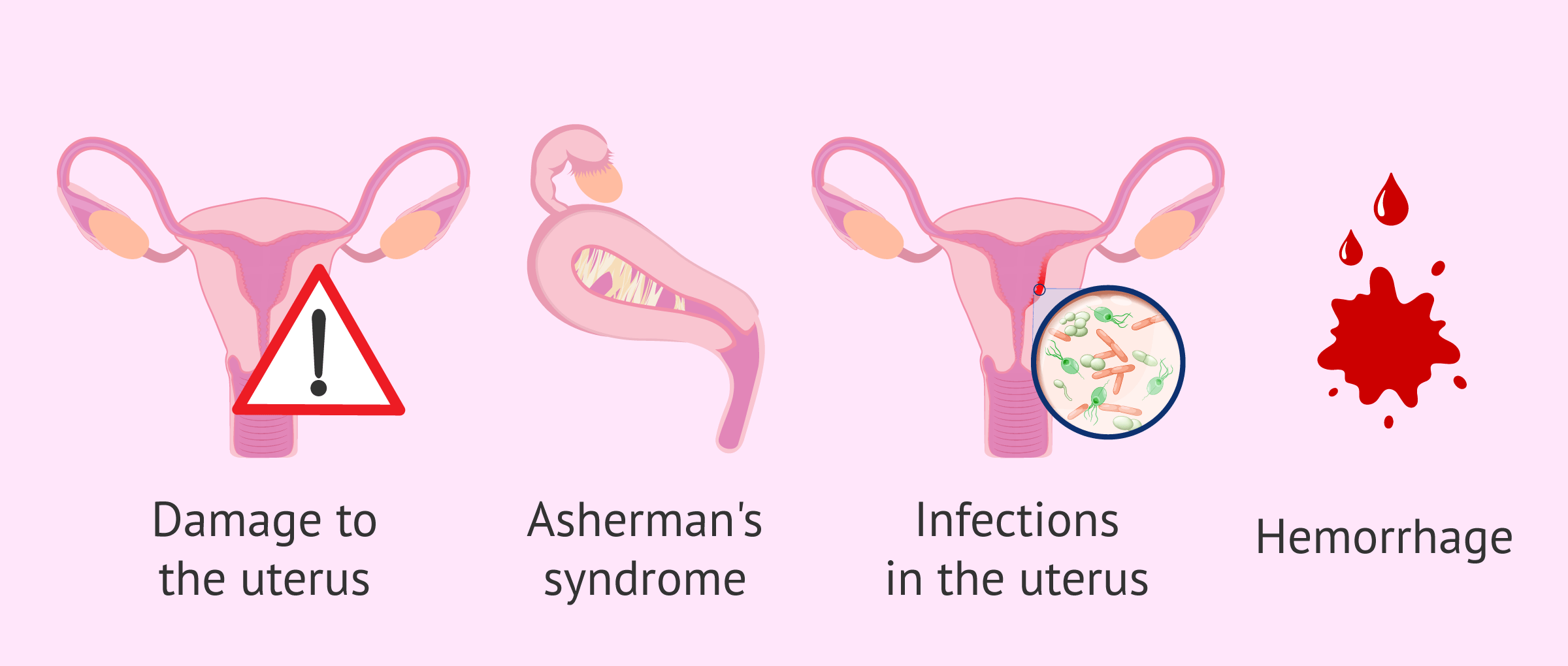Uterine curettage also called curettage, is a gynecological technique that consists of scraping the tissue of the inner walls of the uterus in order to remove the mucous layer of the uterus: the endometrium.
The procedure is performed by a gynecologist under anesthesia and lasts approximately 15 minutes. Although the main indication for curettage is in the case of abortion, this procedure can also be performed in other situations.
Provided below is an index with the 9 points we are going to expand on in this article.
- 1.
- 2.
- 3.
- 4.
- 4.1.
- 5.
- 5.1.
- 6.
- 6.1.
- 6.2.
- 6.3.
- 6.4.
- 6.5.
- 7.
- 8.
- 9.
What is a uterine curettage?
Uterine curettage is a surgical procedure in which the internal walls of the uterus are scraped clean.
Specifically, curettage involves scraping the inner layer of the uterus known as the endometrium, which has the ability to regenerate with each menstrual cycle.
This procedure is quite simple and is performed by a gynecologist under local or general anesthesia, depending on the particular case.
When is curettage performed?
Most women associate curettage with abortion, but this technique actually has several indications that we discuss below:
- Spontaneous abortion
- curettage would be performed to empty the contents of the uterus in case of incomplete abortion or missed abortion, i.e. when an abortion occurs but the embryo is not expelled naturally by bleeding.
- Voluntary or therapeutic termination of pregnancy
- curettage is an option to terminate a pregnancy during the first trimester, either by personal decision of the woman, because her health is at risk or because there is a malformation or genetic alteration in the embryo.
- Diagnosis
- in case of suspected uterine cancer, a uterine curettage with biopsy allows the collection of a sample of endometrial tissue for analysis.
- Irregular menstruation Treatment
- curettage is also used to try to solve bleeding outside the menstrual period, heavy menstruation, etc.
- Polyp removal
- these are growths of endometrial tissue into the cavity of the uterus and can lead to complications such as heavy menstruation, repeated miscarriages, implantation failure, etc. However, it is now very common for these polyps to be removed by surgical hysteroscopy.
However, intrauterine devices (IUDs) used as long-acting contraceptives can become embedded in the endometrium. Therefore, curettage, in this case, serves to remove part of the endometrium that retains the IUD so that it can be removed.
How is curettage performed?
As we have already mentioned, uterine curettage is a very simple procedure that lasts approximately 15 minutes. Even so, it is necessary to administer local or general anesthesia to the patient so that she does not suffer any pain. In general, uterine curettage consists of the following steps:
- Dilation
- consists of opening the cervix to facilitate the introduction of the instruments necessary for curettage into the uterus. To do this, the gynecologist inserts small cylinders through the cervix, which gradually widen and enlarge the cervix to an adequate size.
- Curettage
- is the introduction of a rod, called a curette or curette, which has a small, thin handle at its end in order to scrape the uterine cavity. In this way, the gynecologist will gradually remove the endometrium through the cervix. On the other hand, it is also possible to perform curettage by aspiration of the endometrial tissue.
Currently, there are rods with a built-in camera that allow better targeting of the curettage and, therefore, increase the efficiency and reduce the complications of uterine curettage.
In addition, the handle of these new rods can be heated in such a way that coagulation of the wounds occurs at the same time as the scraping, thus reducing bleeding.
Care after uterine curettage
After undergoing curettage, a woman may have vaginal bleeding for several days due to the procedure.
Nevertheless, the patient may also suffer some discomfort such as abdominal or pelvic pain. In this case, the specialist should be consulted as to what painkillers can be taken to alleviate it.
However, in the event of heavy bleeding or bleeding that does not stop, fever, foul-smelling discharge, severe pain, or any other unusual symptom, it is advisable to see a specialist as soon as possible so that the situation can be assessed.
In spite of this, the recovery time after uterine curettage is very fast. Normally, the woman must rest during the first day, but she can continue with her normal lifestyle and activities the following day, although she must take into account some recommendations:
- Sexual abstinence for at least two weeks after curettage.
- Do not use tampons.
- Do not douche or bathe.
- Avoid intense physical exercise.
In terms of mood, it is normal for a woman to feel sadness and depression if she has suffered a miscarriage. For this reason, it can be very positive for the patient to be accompanied in the days following the curettage and to try to keep herself busy and distracted.
Menstruation after uterine curettage
Vaginal bleeding after curettage has nothing to do with menstruation. It will drop again about 30-40 days after the curettage is performed, although it may vary depending on the situation of each woman.
From this point on, the usual menstrual cycles will resume and ovulation will occur about 15 days later.
Most specialists recommend waiting 2 to 3 months after a curettage before attempting a new pregnancy. In this way, both the woman's physical and emotional state will have recovered.
Risks and complications
Although it is a simple procedure that does not usually involve risks, uterine curettage can lead to some complications such as the following:
- Damage to the uterus
- perforation of the uterus by the rod, tearing of the cervix, etc.
- Asherman's syndrome
- this is a poor healing of the uterine walls, which remain adhered to each other. This leads to a situation of infertility because the uterus becomes deformed and is unable to accommodate a pregnancy.
- Infections of the uterus or pelvic area
- this may occur due to the transfer of microorganisms from the vagina to the uterus when surgical instruments are introduced, or due to the abandonment of endometrial tissue or abortifacient debris inside the uterus after curettage. Symptoms of a possible infection are fever, foul-smelling vaginal discharge and severe pain.
- Hemorrhages
- it is normal to have bleeding from the wound in the uterus, but it will be necessary to make sure that it is not too intense, as this could be due to a major complication.
In addition to all this, the psychological impact of curettage due to miscarriage on the woman must also be taken into account.
Fertility after uterine curettage
The curettage technique itself does not affect the fertility of the woman, so that, after its performance and the appropriate waiting period, the patient can become pregnant.
In fact, in some cases, uterine curettage can improve the infertility problem, for example, when endometrial polyps that cause implantation failure are removed.
However, it is also true that curettage may have some negative effect on fertility due to possible associated complications, such as Asherman's syndrome.
If you are interested in learning more about this topic, you can continue reading in the following article: Fertility after abortion: Is pregnancy possible?
FAQs from users
How long should I wait after a uterine curettage to try to get pregnant by IVF?
After a uterine curettage, whether obstetric or gynecological, we recommend allowing one or two menstrual cycles to pass (depending on each patient) to check the endometrial integrity and return to perform a new embryo transfer.
Uterine curettage is a surgical procedure that consists of scraping the walls of the interior of the uterus in order to remove the mucous layer of the uterus: the endometrium. The IVF cycle can be performed by coordinating a fresh transfer or it can be done previously and the cryotransfer with optimal endometrium can be performed 4/6 weeks after curettage.
What is the price of a uterine curettage?
This surgical intervention is usually performed by the Social Security at no cost, especially when it is necessary to do so due to miscarriages or other pathologies.
In case you want to terminate the pregnancy voluntarily in a private clinic, the cost of surgical abortion in Spain is approximately between 325 and 450 €.
What are the side effects of a uterine curettage?
The symptoms or side effects of curettage are few. In general, there is vaginal bleeding during the days following the intervention, which may be accompanied by cramping in the pelvic area and back pain.
In spite of this, the woman can live a normal life the day after the curettage is performed, since painkillers relieve these discomforts.
Do I need a curettage if hCG levels do not decrease after an abortion?
The specialist will always be the one to assess the situation. It is true that the gynecologist may choose to perform a uterine curettage to eliminate the embryonic remains that cause the hCG not to decrease after the abortion, if they are not expelled naturally.
Is it necessary to take sick leave after a uterine curettage?
This depends on each woman and the cause of the curettage. In general, it is only recommended to rest the day of the intervention and, in some cases, also the following day, but it is common for the woman to soon return to her daily routine.
However, in women who have suffered a miscarriage of several weeks or if the vaginal bleeding is very heavy, the doctor usually gives about a week off work. This will also depend on the woman's type of work and what her duties are.
Recommended readings
One of the questions that most worries women who have undergone a curettage is when they will be able to try to get pregnant again. You will find all the information about this here: How long does it take after an abortion to try to get pregnant?
We have also mentioned Asherman's syndrome as a possible complication after uterine curettage. If you are interested in reading more about this topic, you can access the following article: What is Asherman's syndrome - Causes, symptoms, and treatment?
We make a great effort to provide you with the highest quality information.
🙏 Please share this article if you liked it. 💜💜 You help us continue!
References
Georgiyants M, Iakovlieva L, Kolesnyk A, Vysotska O, Yurchenko O. ECONOMIC EFFECTIVENESS OF DIFFERENT METHODS OF ANESTHESIA OF CURETTAGE OF UTERINE CAVITY. Georgian Med News. 2019 Feb;(287):13-19. (Ver)
Georgiyants MA, Kolesnik GV, Vysotska OV, Yurchenko OM. The influence of various methods of anesthesia on time of postoperative recovery of patients' conciousness after curettage of uterine cavity. Wiad Lek. 2019;72(3):336-342. (Ver)
Mesci-Haftaci S, Ankarali H, Yavuzcan A, Caglar M. Endometrial curettage in abnormal uterine bleeding and efficacy of progestins for control in cases of hyperplasia. Asian Pac J Cancer Prev. 2014;15(8):3737-40. (Ver)
Piątek S, Lipa J, Górska M, Malecha K, Panek G, Wielgoś M. Is routine performance of the uterine cervix canal curettage prior to the curettage of the uterine cavity justified? Ginekol Pol. 2017;88(9):463-468. (Ver)
Piriyev E, Mellin W, Römer T. Comparison of aspirating pipettes and hysteroscopy with curettage. Arch Gynecol Obstet. 2020 Jun;301(6):1485-1492. (Ver)
Salazar CA, Isaacson K, Morris S. A comprehensive review of Asherman's syndrome: causes, symptoms and treatment options. Curr Opin Obstet Gynecol. 2017 Aug;29(4):249-256. (Ver)
van Hanegem N, Prins MM, Bongers MY, Opmeer BC, Sahota DS, Mol BW, Timmermans A. The accuracy of endometrial sampling in women with postmenopausal bleeding: a systematic review and meta-analysis. Eur J Obstet Gynecol Reprod Biol. 2016 Feb;197:147-55. (Ver)
FAQs from users: 'How long should I wait after a uterine curettage to try to get pregnant by IVF?', 'What is the price of a uterine curettage?', 'What are the side effects of a uterine curettage?', 'Do I need a curettage if hCG levels do not decrease after an abortion?' and 'Is it necessary to take sick leave after a uterine curettage?'.
Authors and contributors

More information about Cristina Algarra Goosman








Hi, a few months ago I had a 7-week miscarriage, she stopped beating her heart. It was very difficult to assimilate and I had a very hard time during the curettage. We want to try again but I don’t know when we should start. I am scared that I have not healed and will lose the next baby too.
Hello Cheyenne,
I am sorry for your loss, the World Health Organization recommends waiting 6 months after a miscarriage to start trying for a second pregnancy. However other professionals reduce that time to 2 months.
I recommend that you go to your doctor so that he/she can do a scan to confirm that everything is okay and you can go ahead and try for a new pregnancy.
Here is an article that explains the characteristics of pregnancy after miscarriage: How long does it take after a miscarriage to try to get pregnant?
I hope I have helped you.
Best regards.